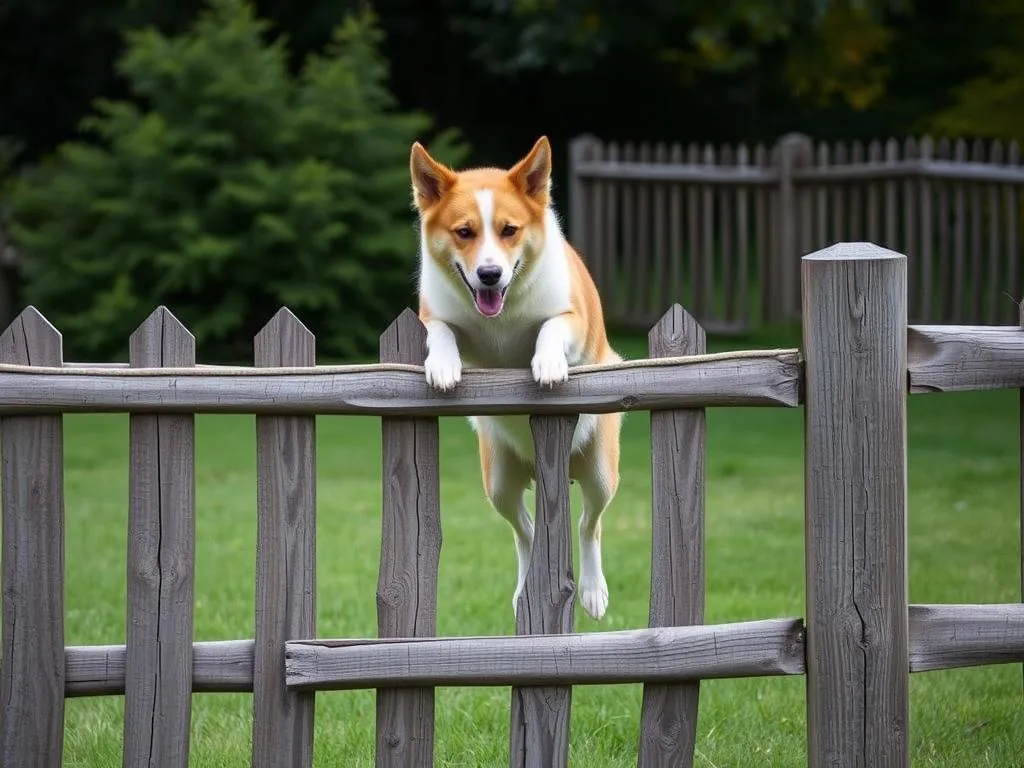
Importance of Dog Training
Training your dog is not just about teaching them commands; it’s essential for their safety and your peace of mind. A well-trained dog is less likely to engage in dangerous behaviors, such as jumping or climbing the fence. These actions can lead to accidents, injuries, or even getting lost.
Common Behavior
Dogs are naturally curious and often try to explore their environment. Factors such as boredom, anxiety, or territorial instincts can drive them to jump or climb fences. Understanding these motivations is crucial for effective training.
Objective
The goal here is to equip you with effective strategies to prevent your dog from engaging in these behaviors, ensuring they remain safe within your yard while providing you with peace of mind.
Understanding the Behavior
Reasons Dogs Jump or Climb Fences
Dogs jump or climb fences for various reasons, many of which stem from their natural instincts:
- Instinctual Behavior: Dogs are pack animals with a natural instinct to explore their surroundings. This exploration can lead them to attempt to jump or climb over barriers.
- Boredom and Lack of Exercise: A dog that doesn’t receive enough physical activity is more likely to seek entertainment elsewhere. This can manifest in jumping or climbing as a form of self-stimulation.
- Territorial Aggression: Dogs often feel the need to protect their territory. If they perceive a threat outside their fence, they may jump to confront it.
- Anxiety or Fear: Dogs experiencing separation anxiety or fear of loud noises may attempt to escape in search of safety or comfort.
- Curiosity about the Outside World: The sights and sounds beyond the fence can be enticing. Dogs may jump to investigate what lies beyond their immediate environment.
Assessing Your Dog’s Personality
Understanding your dog’s personality can help identify why they may be attempting to jump or climb the fence:
- Energy Level: High-energy breeds like Border Collies or Jack Russell Terriers may be more prone to jumping due to their need for physical and mental stimulation.
- Breed-Specific Traits: Some breeds are naturally more agile and capable of climbing or jumping. For instance, Greyhounds are known for their speed and ability to leap.
- Previous Experiences: If a dog has experienced trauma or instability in the past, they may be more likely to exhibit anxious behaviors, including fence jumping.
Preventative Measures
Physical Modifications
Making changes to your environment can significantly reduce the chance of your dog jumping or climbing the fence:
- Heightened Fencing: Depending on your dog’s breed and size, consider a fence that is at least 6 feet tall. Taller fences can deter most breeds from jumping.
- Secure Fencing Materials: Use solid materials, like wood or vinyl, instead of chain-link fences, which may allow dogs to see and entice them to jump.
- Adding Barriers: Landscaping features such as bushes or shrubs can obstruct jumping paths, making it more difficult for dogs to gain leverage.
- Anti-Jump Fencing Solutions: Explore options like angled fence tops or specially designed fencing that discourages jumping.
Environmental Enrichment
Providing mental and physical stimulation can help alleviate the urge to jump:
- Exercise Routines: Regular walks, playtime, and other forms of exercise are crucial. Aim for at least 30 minutes of vigorous activity daily.
- Interactive Toys: Investing in toys that challenge your dog’s mind can keep them engaged and reduce boredom.
- Socialization: Interaction with other dogs can fulfill their social needs, reducing the desire to escape in search of companionship.
Training Techniques
Basic Obedience Training
Teaching your dog basic commands can significantly help in managing their jumping behavior:
- Commands to Reinforce Boundaries: Teaching commands like “stay” and “leave it” can help your dog understand what behaviors are not acceptable.
- Positive Reinforcement: Use treats or praise to reward your dog when they remain calm and refrain from jumping.
Specialized Training Techniques
If basic training doesn’t resolve the issue, consider specialized techniques:
- Desensitization: Gradually exposing your dog to stimuli that trigger their jumping can help them learn to remain calm in those situations.
- Redirecting Energy: Instead of allowing your dog to jump, redirect their energy into more acceptable behaviors, such as playing with a toy or practicing commands.
- Clicker Training: This technique can be particularly effective. Use a clicker to mark the desired behavior when your dog stays calm near the fence, followed by a reward.
Addressing the Issue
Identifying Triggers
Understanding what specifically triggers your dog’s jumping behavior is essential:
- Observation Techniques: Spend time observing your dog to note what excites them enough to jump. This could include other animals, people, or loud noises.
- Creating a Trigger List: Keep a journal of observed triggers. This can help in developing a targeted training plan.
Implementing a Training Plan
A structured plan can lead to better outcomes:
- Setting Realistic Goals: Establish achievable training objectives. Start small, like reducing the frequency of jumping before aiming for complete prevention.
- Consistency is Key: Consistent training practices are essential for success. Ensure everyone in the household follows the same guidelines and commands.
- Involving Family Members: Ensure that all family members are on the same page regarding training to provide a unified approach.
Professional Help
When to Seek Professional Training
Sometimes, self-training may not yield the desired results, and it may be time to consult a professional:
- Signs That Self-Training Isn’t Working: If your dog continues to jump despite your best efforts, it may be time to seek help.
- Finding a Qualified Trainer: Look for trainers who specialize in behavioral issues and have positive reviews.
Behaviorists vs. Trainers
Understanding the differences between trainers and behaviorists can help you choose the right professional:
- Understanding the Differences: Trainers typically focus on obedience and basic commands, while behaviorists address underlying behavioral issues.
- Potential Costs and Commitments: Be prepared for varying costs and time commitments. Training sessions can range from a few sessions to ongoing support, depending on your dog’s needs.
Conclusion
Understanding why dogs jump or climb fences is essential for preventing these behaviors. Implementing physical modifications, providing environmental enrichment, and utilizing effective training techniques can significantly reduce the urge to escape. Patience and consistency in your approach will ultimately lead to success. If self-training doesn’t yield results, don’t hesitate to seek professional help. Your dog’s safety and well-being are worth the investment.









